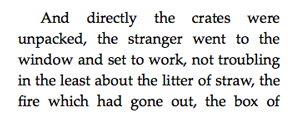Earlier this year, we released an update that addressed a lower-than-expected page count (KENPC) for eBooks listed with Amazon’s Kindle Unlimited. That change, detailed in a previous post, made page counts for eBooks created with Vellum comparable to eBooks formatted with other methods. However, we’ve recently received questions about a few eBooks that, when upgraded to use Vellum, resulted in a lower KENPC than before.
Providing an answer to these questions required some understanding of how KENPC is calculated. Many have wondered if KENPC is based on metrics like file size, character count, number of locations, or if it’s computed by analyzing the internal structure of files within an eBook.
After some tests, it seems that KENPC is computed in a manner similar to the page count of a physical book. The same factors that would affect a physical page count can change KENPC.
That means, for example, that specifying a large font for your eBook can actually increase the KENPC:


In our test, specifying a larger-than-normal font size increased page count by 25%. Greater line spacing, added paragraph spacing — essentially, all the tricks you learned to stretch the length of a term paper — can also be used to increase page count.
But it can go the other way, too: some styling changes can decrease KENPC. Changing text to use standard indentation and spacing creates a more professional result, but can lower page count (though typically by a smaller amount):


These differences are, of course, something most thought shouldn’t happen with KENPC. The N in KENPC stands for normalized, and Amazon claims that KENPC calculations are “based on standard settings (e.g. font, line height, line spacing, etc.).” Unfortunately, that doesn’t seem to be the case.
We understand that KENPC affects income, and so we’ve debated adding options like a larger font size, or extra paragraph spacing. But we don’t think that’s the right choice. These options would produce less attractive books, create a poor experience for the reader, and ultimately harm all authors enrolled in Kindle Unlimited. So at this time, we are not adding any options solely for the sake of increasing KENPC.
We’ve heard rumors of improvements to Amazon’s KENPC calculations that would address these differences, and prevent authors from feeling like they need to choose between reader experience and additional income. We sincerely hope they pan out.
Update 2/1/16: Amazon has released KENPC 2.0.